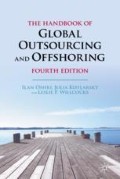Abstract
As we have illustrated, the global sourcing market is large and the services offered range from relatively simple processes such as data entry to very complex projects such as the digital transformation of the enterprise. The supplier base is equally diverse, ranging from locally based firms specialising in particular services or industries to offshore or global suppliers offering high-quality services at a low cost. Tables 5.1, 5.2, and 5.3 identify the dominant players in the sourcing market as follows: the top ten outsourcing companies (Table 5.1), the top outsourcing advisers (Table 5.2), and the top ten BPO companies in India (Table 5.3). These rankings provide important information regarding the expertise of a number of suppliers and thus help clients identify potential partners. Of course, these rankings may change over time as existing, developing, and new players increasingly compete across global geographies. For example, cloud services have been growing dramatically during the 2020s, with the dominant Amazon Web Services (AWS) offering on-demand cloud computing platforms and APIs to individuals, companies, and governments, on a metered pay-as-you-go basis. In 2021 AWS represented around 32% of the $US40 billion plus cloud market, but there are many other players and many niches. For example, in the early 2020s the open talent cloud-based market was just starting up, while Salesforce is a major player in the cloud SaaS market.
This chapter provides an overview of suppliers, supplier configurations, and the role played by intermediaries. The supplier landscape will be discussed in terms of firm size, areas of specialisation and location, with a focus on supplier core capabilities and supplier strategies for sustainability and growth.
In this chapter, we focus on:
-
The role of suppliers and intermediaries in sourcing arrangements
-
A supplier’s core capabilities for sustainability and growth
-
Suppliers’ strategies for growth.
Access this chapter
Tax calculation will be finalised at checkout
Purchases are for personal use only
References
Agarwal, M. K., Frambach, R. T., & Stremersch, S. (2000). Does size matter? Disentangling consumers’ bundling preferences. Vrije Universiteit, Faculty of Economics, Business Administration and Econometrics.
Ethiraj, S. K., Kale, P., Krishnan, M. S., & Singh, J. V. (2005). Where do capabilities come from and how do they matter? A study in the software services industry. Strategic Management Journal, 26, 25–45.
Feeny, D., Lacity, M., & Willcocks, L. P. (2005). Taking the measure of outsourcing providers. MIT Sloan Management Review, 46(3), 41–48.
Harris, J., & Blair, E. A. (2006). Functional compatibility risk and consumer preference for product bundles. Journal of the Academy of Marketing Science, 34(1), 19–26.
Kotlarsky, J., Oshri, I., Kumar, K., & van Hillegersberg, J. (2007). Globally distributed component-based software development: An exploratory study of knowledge management and work division. Journal of Information Technology, 22(2), 161–173.
Kotlarsky, J., Oshri, I., Dibberns, J., & Mani, D. (2020). Information systems sourcing. MIS Quarterly, curation article.
Krancher, O., Oshri, I., Kotkarsky, J., & Dibbern, J. (2022). Bilateral, collective, or both? Formal governance and performance in multisourcing. Journal of the Association of Information Systems, 21(1).
Lacity, M., & Willcocks, L. (2009). Information systems and outsourcing: Studies in theory and practice. Palgrave.
Levina, N., & Ross, J. W. (2003). From the vendor’s perspective: Exploring the value proposition in information technology outsourcing. MIS Quarterly, 27(3), 331–364.
Levina, N., & Su, N. (2008). Global multisourcing strategy: The emergence of a supplier portfolio in services offshoring. Decision Sciences, 39(3), 541–570.
Lioliou, E., & Willcocks, L. (2019). Global outsourcing discourse: Exploring modes of IT governance. Palgrave Macmillan.
Mahnke, V., Wareham, J., & Bjorn-Andersen, N. (2008). Offshore middlemen: Offshore intermediation in technology sourcing. Journal of Information Technology, 23(1), 18–30.
Oshri, I. (2014). Innovation through outsourcing: Have you got the goods. National Outsourcing Association Year Book.
Oshri, I., & Kotlarsky, J. (2014, July). Four ways to multisource. Professional Outsourcing Magazine, 17, 50–54.
Oshri, I., Kotlarsky, J., & Willcocks, L. P. (2007). Managing dispersed expertise in IT offshore outsourcing: Lessons from TATA consultancy services. MIS Quarterly Executive, 6(2), 53–65.
Oshri, I., Kotlarsky, J., & Gerbasi, A. (2018). Relational and contractual governance for innovation. In L. Willcocks, I. Oshri, & J. Kotlarsky (Eds.), Dynamic innovation in outsourcing. Palgrave Macmillan.
Oshri, I., Dibbern, J., Kotlarsky, J., & Krancher, O. (2019). An information processing view on joint-vendor performance in multi-sourcing: The role of the guardian. Journal of Management of Information Systems, 36(4), 1248–1283.
Su, N., & Levina, N. (2011). Global multisourcing strategy: Integrating learning from manufacturing into IT service outsourcing. IEEE Transactions on Engineering Management.
Wiener, M., & Saunders, C. (2014). Forced coopetition in IT multi-sourcing. Journal of Strategic Information Systems, 23, 210–225.
Willcocks, L. P. (2021a). Global business: Management. SB Publishing.
Willcocks, L. P. (2021b). Robo-Apocalypse? Response and outlook on the post-COVID-19 future of work. Journal of Information Technology, 36(2), 188–194.
Willcocks, L. P., & Lacity, M. (2006). Global so‑urcing of business and IT services. Palgrave.
Willcocks, L. P., Cullen, S., & Lacity, M. (2006). The CEO guide to selecting effective suppliers. Logica Internal Report.
Willcocks, L. P., Griffiths, C., & Kotlarsky, J. (2009). Beyond BRIC. Offshoring in non-BRIC countries: Egypt – A new growth market. The LSE Outsourcing Unit Report. LSE.
Willcocks, L. P., Oshri, I., & Hindle, J. (2009). Client’s propensity to buy bundled IT outsourcing services. White Paper for Accenture.
Author information
Authors and Affiliations
Corresponding author
Rights and permissions
Copyright information
© 2023 The Author(s), under exclusive license to Springer Nature Switzerland AG
About this chapter
Cite this chapter
Oshri, I., Kotlarsky, J., Willcocks, L.P. (2023). Supplier Configurations and Capabilities. In: The Handbook of Global Outsourcing and Offshoring. Palgrave Macmillan, Cham. https://doi.org/10.1007/978-3-031-12034-3_5
Download citation
DOI: https://doi.org/10.1007/978-3-031-12034-3_5
Published:
Publisher Name: Palgrave Macmillan, Cham
Print ISBN: 978-3-031-12033-6
Online ISBN: 978-3-031-12034-3
eBook Packages: Business and ManagementBusiness and Management (R0)

